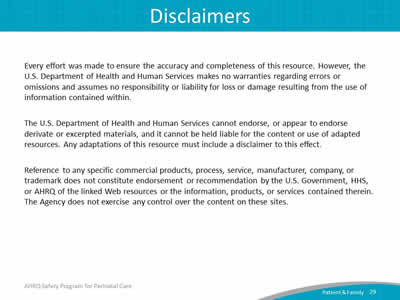Patient and Family Engagement for Perinatal Safety: Facilitator Guide
AHRQ Safety Program for Perinatal Care
Slide 1: Patient and Family Engagement for Perinatal Safety

Say:
The Patient and Family Engagement module focuses on an important topic: making sure patients and their family members understand what is happening during the patient's hospital stay and are active participants in the patient's care.
Slide 2: Learning Objectives

Say:
In this module we will—
- Introduce the concept of patient-and family-centered care and define patient and family engagement.
- Present tools to improve communication among patients, families, and clinicians.
- Explore the role of patient and family advisors in ensuring that patients' and families' views are incorporated into hospital policies and procedures and describe how to work with patient and family advisors as part of the implementation team.
- Discuss how to communicate an adverse event to patients and family members.
Slide 3: The Patient's Hospital Experience

Say:
Being aware of what patients face when they are in the hospital can help labor and delivery or L&D unit staff better understand a patient's perspective.
- Hospitals can present a very unfamiliar setting, system, and culture for patients.
- Patients may not understand the roles of different staff on their care team.
- Patients are often in pain and may feel vulnerable in the hospital.
- Patients may be hesitant to make requests of busy staff.
Slide 4: Patient- and Family-Centered Care

Say:
According to the Institute for Patient- and Family-Centered Care, patient- and family-centered care involves "collaborating with patients and families of all ages, at all levels of care, and in all health care settings. It acknowledges that families, however they are defined, are essential to patients' health and well-being."
Core concepts of patient- and family-centered care include dignity and respect, information sharing, participation, and collaboration.
Slide 5: What Is Patient and Family Engagement?

Say:
The goal of patient and family engagement is to create a set of conditions in which patients, family members, clinicians, and hospital staff work together as partners to improve the quality and safety of care. This partnership is important because health care quality and safety directly affect patients and families.
Slide 6: Engagement Strategies

Say:
A team should consider using these three engagement strategies:
- Engaging in everyday care.
- Engaging after an adverse event.
- Engaging in planning and design.
Slide 7: Engaging in Everyday Care

Say:
On one level, patient and family engagement means providing day-to-day care experiences that welcome and engage patients and families as members of the health care team. For example, care team members can provide opportunities for patients and family members to be involved in their care by—
- Inviting patients and family members to partner with their health care team throughout the patient's stay.
- Conducting change-of-shift report at the bedside so patients and families can participate.
- Involving patients and families in discharge planning and plans for safe care at home.
Slide 8: Engaging From the Beginning

Say:
How hospital staff members communicate with patients and families can affect patient engagement. Simple actions, such as entering a room and assessing a patient, can affect the patient's attitude toward her care.
Entering a room
L&D unit staff responsible for a patient's care should read the patient's chart before stepping into the patient's room. Once they enter a room, they should—
- Make eye contact with the patient and her family.
- Introduce themselves by name and role.
- Introduce new people in the room by name and role, and explain what they will do.
Slide 9: Engaging at the First Assessment

Say:
Assessing a patient
When L&D staff first assess the patient, they should—
- Ask how the patient prefers to be addressed.
- Identify family members or others, such as a doula, who are involved in the patient's care, and highlight main points of communication tools—for example, call button, phone, rapid response activation procedures, whiteboards.
- Invite the patient and family members to write questions on the whiteboard to "talk" with the clinicians.
Slide 10: The Link Between Communication and Patient Safety

Say:
Communication among L&D team members and patient and family members is important to the delivery of high-quality, patient-centered care.
Effective communication and collaboration with patients and family members affect patient outcomes, patient safety, and perceptions of quality. If patients feel involved in their care, they will be more likely to follow their treatment plans and may experience better clinical outcomes.
Slide 11: Communication Tips

Say:
When communicating with patients and their families, unit team members should follow the tips below to ensure their messages are communicated clearly.
Educate the patient and family in these ways:
- Speak slowly.
- Use plain language.
- Reassure the patient and family by providing information.
- Thank the patient or family for raising concerns.
- Invite questions.
Slide 12: Listening and Explaining
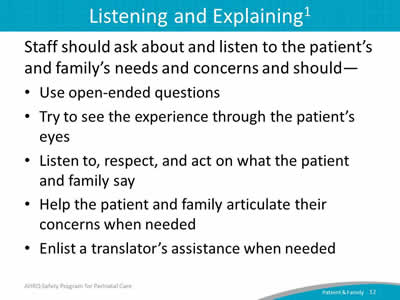
Say:
L&D staff should ask about and listen to the patient's and family's needs and concerns. They should—
- Use open-ended questions, not questions that can be answered with a"yes" or "no."
- Try to see the experience through the patient's eyes.
- Listen to, respect, and act on what the patient and family say.
- Help the patient and family articulate their concerns.
- Enlist the help of a translator for the patient or family member when necessary.
Slide 13: Role of a Doula
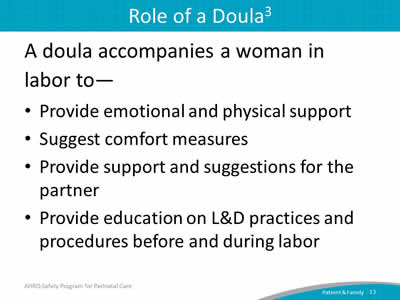
Say:
Day-to-day patient and family engagement on the L&D unit can also be enhanced by the presence of other members of a birthing team, such as a doula.
A doula provides continuous physical, emotional, and informational support to the mother before, during, and just after birth. They often attend births, and their presence provides various benefits to the mother and her family. A doula—
- Provides emotional and physical support before, during, and after labor.
- Suggests comfort measures during labor to the woman and her partner.
- Provides support and suggestions for the partner (both on how to cope themselves and how to support their partner).
- Provides education on L&D practices and procedures before and during labor.
Slide 14: Role of a Doula
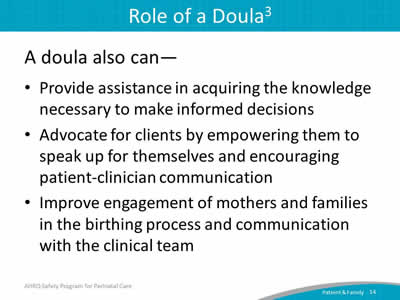
Say:
A doula also—
- Provides assistance in acquiring the knowledge necessary to make informed decisions during pregnancy,labor, delivery, and postpartum.
- Advocates for clients by empowering clients to speak up for themselves and encourages patient/clinician communication.
- Improves engagement of mothers and families in the birthing process and in their communication with the clinical team.
Slide 15: Engaging With the Help of a Doula
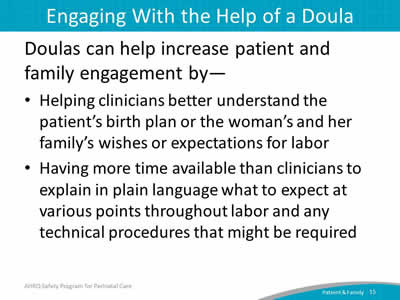
Say:
Doulas are a great resource for increasing patient and family engagement in the L&D unit. For example—
- Clinicians and nurses can work with a doula to better understand the patient's birth plan or any wishes or expectations the woman and her family have for labor.
- Doulas may have more time available than clinicians to explain in plain language what to expect at various points throughout labor and any technical procedures that might be required.
Slide 16: Engaging With the Help of a Doula
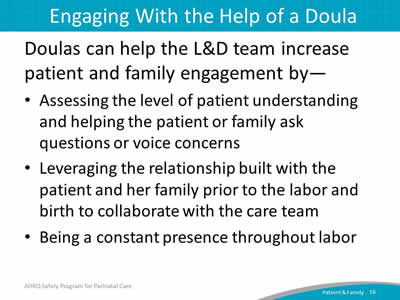
Say:
- Doulas can also assess level of patient understanding and help the patient or family ask additional questions or voice concerns.
- Doulas have usually worked hard to build a relationship with their patient and their families prior to the labor and birth. If clinicians are having a difficult time interacting with a patient or the patient's family, often a doula can be very helpful as an intermediary in working with the family because of their preexisting relationship and trust.
- Doulas are a constant presence throughout labor. They rarely take breaks and pay special attention to how a mother is coping with labor. Because clinicians are busy and often in and out of the room, they can engage with doulas and rely on them for a longitudinal perspective on how the patient is coping with labor, what her energy levels are, and how she is doing emotionally.
Slide 17: Engaging After Adverse Events
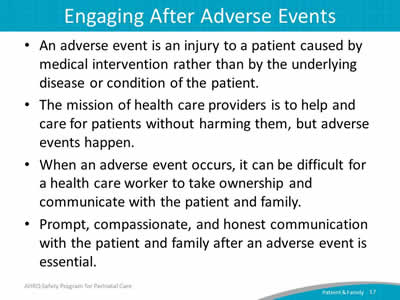
Say:
Adverse events occur when a patient is harmed as a result of receiving medical care. Medical providers are committed to caring for their patients; however, adverse events can happen. When they do, staff members need to know how to communicate with the patient and family.
Prompt, compassionate, honest, and accurate communication with the patient and family after an adverse event ensures that they receive information they can use to chart their next steps.
Slide 18: Immediate Response to an Adverse Event
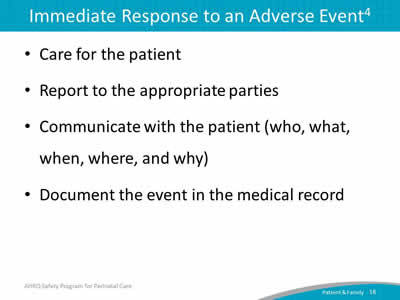
Say:
Each hospital has policies and procedures for actions to take after an adverse event occurs, and most involve working with a risk-management professional. Immediately after an adverse event, care providers:
- Provide care. Caring for the patient's physical needs after an event is the first step a provider must take.
- Report. Providers report the incident tot he unit manager and the risk-management department, according tot he hospital's incident-reporting policy.
- Communicate. Providers communicate the facts of what happened and assure the patient and family that they will receive new information as it is discovered. We will discuss this in more detail in a moment.
- Document. Providers must document in the medical record the facts of the incident and any care the patient received as a result of the incident. The discussion with the patient and family should also be documented. The documentation should include an objective description of the event, the patient's response to the event, and the care provided as a result of the event.
Slide 19: Adverse Event Initial Communication
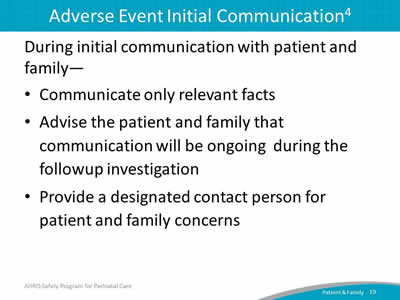
Say:
Communication is an ongoing process that occurs from initial reporting of the incident through investigation and resolution. Generally, only findings that are reasonably certain to have occurred and unlikely to change should be reported to the patient and family.
During the initial communication with the patient and family, providers should—
- Communicate only relevant facts that are reasonably certain at the time because further investigation and resolution may be necessary.
- Advise the patient and family that communication will be ongoing as the follow up investigation progresses.
- Advise the patient and family of a designated contact person for their questions and concerns.
Slide 20: How To Communicate About an Adverse Event
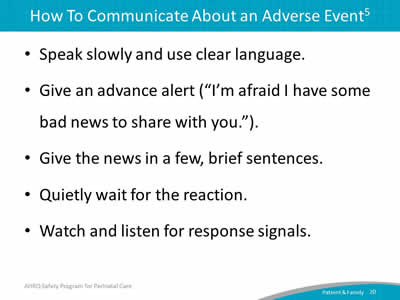
Say:
Patients and family members experience a number of emotions when an adverse event occurs. The care provider should speak slowly and use clear language. The provider should begin with an alert, such as, "I'm afraid I have some news I need to share with you," and then provide the information in a few short sentences. The provider should wait for a response. A hospital committed to transparency offers an apology that the incident happened.
Slide 21: Next Steps in Responding to an Adverse Event
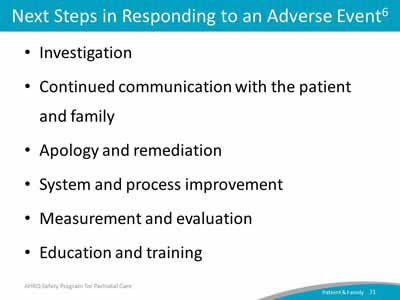
Say:
When an incident occurs, the hospital will investigate and analyze it (e.g., a root cause analysis may be conducted) to determine whether patient harm occurred. When the hospital determines that unreasonable care was provided, the following information should be communicated to the patient and family:
- An apology for any unreasonable care.
- An explanation of what happened.
- A meaningful discussion of projected outcomes.
- An early offer of remediation (such as waiving hospital bills) and compensation.
The hospital should use information learned from the investigation to identify and implement system and process improvement. It should track, trend, and analyze necessary data for quality assurance and other identified purposes. The hospital should also establish initial and continual training requirements for professional, administrative, and support staff.
Slide 22: The Second Victim: Health Care Workers
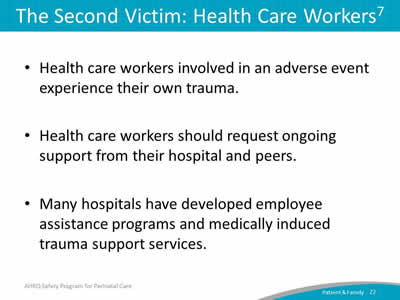
Say:
Adverse events are often system failures. Rarely does an adverse event occur as a result of intent. Health care workers hold themselves to very high standards, and when an incident happens, they should request support from the hospital and their peers to regain their confidence. Hospitals today recognize that health care workers are the second victims of adverse events and often provide psychological support through employee assistance programs and medically induced trauma support services after an incident occurs.
Slide 23: Engaging in Planning and Design: Continuing Patient and Family Involvement
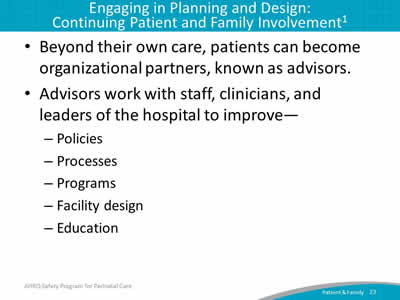
Say:
Beyond the clinical team's engaging current patients and their families directly, patient and family engagement means that patients and family members are involved beyond their own care as organizational partners or advisors. Examples include working with staff, clinicians, and leaders to improve policies, processes, programs, facility design, and education for hospital staff, clinicians, and trainees in the health professions. In addition to serving as part of the unit team to provide their perspective, patients and their family members can also be advisors to the hospital staff to improve policies and procedures.
Slide 24: Who Are Advisors and What Do They Do?
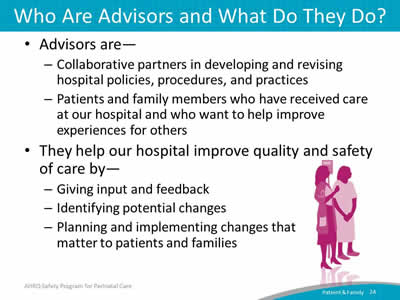
Say:
A patient and family advisor is a former patient or family member of a patient who is a collaborative partner at all stages in developing hospital policies, procedures, and practices.
For more information on an advisor's role and responsibilities, patients and family members who are interested in becoming advisors can refer to the Am I Ready to Become an Advisor? tool, which is listed as one of several tools at the end of this module.
Advisors collaborate with hospital staff to develop patient- and family-centered policies and procedures. Hospital staff members rely on the opinions of patient and family advisors and consult them when deciding matters concerning patient experiences, care delivery, educational materials, and facility design.
For more information on how to partner with advisors, hospitals can refer to the Working with Advisors handout, which is listed as one of several tools at the end of this module.
Slide 25: Summary
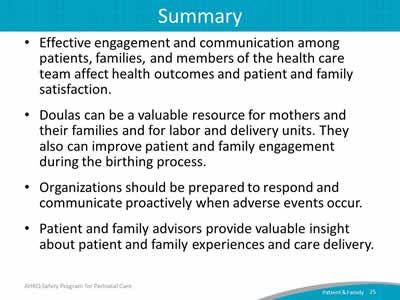
Say:
- Effective engagement and communication among patients, family members, and other members of the health care team can benefit health outcomes and patient and family satisfaction.
- L&D staff can involve patients and families in day-to-day care, welcoming and engaging them as members of the health care team.
- Doulas can be a valuable resource form others and their families and for labor and delivery units. They also can improve patient and family engagement during the birthing process.
- Organizations need to engage in strategies to address adverse events.
- Patient and family advisors provide valuable insight about patient and family experiences and care delivery.
Slide 26: Tools
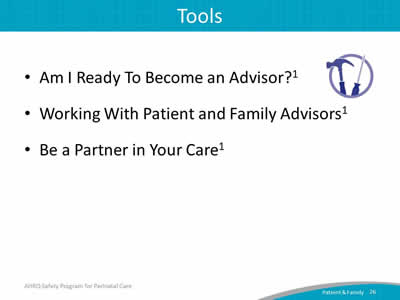
Say:
In addition to the information presented in this module, CUSP tools are available through the Safety Program for Perinatal Care.
The tools in this module will help clarify the roles and responsibilities of advisors as part of the CUSP team and present communication strategies for patients and family members.
Am I Ready to Become an Advisor?
This tool provides a series of statements to help someone determine whether they are ready to become an advisor. Sample statements include—
- I am willing to talk about the positive and negative care experiences I had as a patient or family member of a patient.
- If I had any negative experiences, I am coping well and am ready to respectfully share my ideas about how things could have gone differently.
Working with Patient and Family Advisors
This handout discusses the importance of working with patient and family advisors and ways an organization can engage patient and family advisors.
Be a Partner in Your Care
This handout gives information on routine events and highlights tools the hospital uses to talk with the patient and family (e.g., whiteboards). It summarizes the main action items from the other handouts for the patient, family, and clinicians.
Slide 27: References
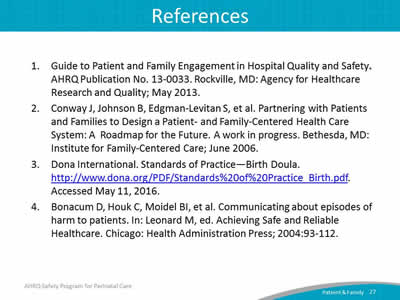
Slide 28: References
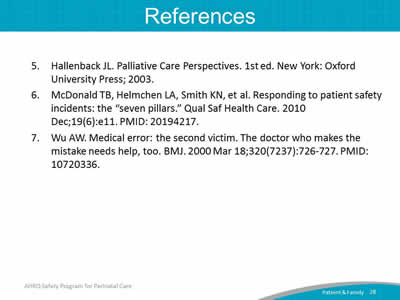
Slide 29: Disclaimers
